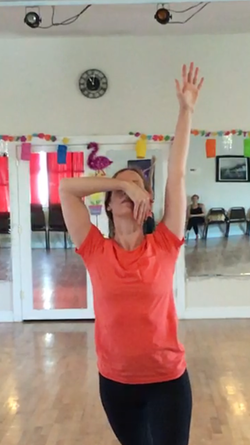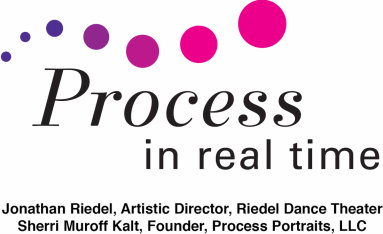 It is with mixed emotions that we must announce the end of this project for Jonathan and Maggie. We are greatly relieved that Maggie’s husband has made a full recovery. We are thrilled that Maggie has found two new jobs that fulfill and inspire her. We are disappointed, however, that Maggie will simply not have the time to continue to collaborate on Jonathan’s new work. So here we are at a turn in the road. Uncertainty abounds: Who will Jonathan find to replace Maggie? How will it feel to continue developing the material with a new dancer? When will Jonathan feel ready to resume this work? For Process in Real Time, this solo was our first project. We’ve been immersed in the psychological, technical, and contextual dynamics influencing the development of the dance. Will we have the chance to continue our exploration any time soon – if ever? On a personal level, Jonathan will miss working with Maggie on a regular basis. He loved their collaboration and, with it, their deepening friendship. It was a joy to work with such a kind, thoughtful, and generous colleague. These feelings are mitigated somewhat by his enthusiasm for his new endeavor, Second Story Dance Project. Also, Jonathan is relieved that he and Maggie completed the first part of the solo, so he is able to move forward with a finished section and no incomplete material. At this time, we don’t yet know which direction we will choose, but we’ll try to let the journey proceed organically. With best wishes to Maggie and her family and gratitude for an enriching experience, Sherri and Jonathan
0 Comments
We can really see the myriad internal experiences and external circumstances that are shaping the development of Jonathan’s work with Maggie. Medical issues predominate during this unexpected interruption in the creation of the solo. The stress of serious illnesses and medical events has been enervating for both Jonathan and Maggie. They have been attending to the ongoing health needs of close family members while confronting a great deal of uncertainty about both diagnoses and prognoses. The physical responsibilities of caretaking coupled with the attendant fear, sadness, anxiety, and exhaustion have been quite challenging. Besides navigating the crises, they must still take care of household and child care needs. Clearly, they have had no choice but to suspend rehearsals indefinitely. For the moment, Jonathan and Maggie have lost a key creative outlet, and the momentum fueling their progress has stalled. Both partners wonder how these developments will impact their artistic collaboration moving forward. Will they simply pick up where they left off? Will a period of review be required? How quickly will they find their working rhythm? Will they re-examine their ideas about how to best convey the key themes of the piece? Stay tuned as the process continues. KEY MEDICAL HIGHLIGHTS
We are also reminded that life evokes the full spectrum of emotional experiences – often at the same time. So right alongside the challenges are personal and artistic developments that engender in Jonathan an increasingly grounded sense of self. He is better able to acknowledge his creative needs and commit to feeding them – even if he is not quite sure what that will look like. Consequently, he has allowed himself to capitalize on and develop artistic opportunities that are already bringing him joy and creative fulfillment. He is acting on his inclinations and asserting his ideas despite the uncertainty about his colleagues’ reception to them. He also experiences less self-doubt and angst when allowing his internal compass to guide his process. Jonathan and Sherri repeatedly challenge his preconceived ideas about his personal and professional roles and approaches. Identifying the “shoulds” Jonathan has inculcated and contrasting them with the messages emanating from his core helps him carve paths that are truly authentic. It has been a process consisting of intermittent, incremental steps, but we can now take a retrospective look at the progress – and see that the bits and pieces of creative re-animation are coalescing into a creative self filled with richness and possibility. CREATIVE OUTLET HIGHLIGHTS
Of course, we will always wrestle with constantly changing dynamics; we are reminded that life is not a smooth, straight line, but more like a 3-dimensional zig zag. We have seen this play out in high relief with regard to Jonathan’s child care situation. Potential babysitters don’t show up for interviews. Intricate, barter-like arrangements are made with other parents. Changing circumstances for family members affect their availability to watch the kids. Financial details threaten to derail child care plans with a favored caregiver. Jonathan must repeatedly adjust to each development, devising creative – if less than ideal – solutions. Once again, Jonathan and Maggie grapple with many unanticipated obstacles.
Wednesday, July 27, 2016 PROCESS DETAILS TECHNICAL SHERRI
JONATHAN
MAGGIE
PSYCHOLOGICAL/EMOTIONAL JONATHAN
MAGGIE
Friday, July 22, 2016 PROCESS DETAILS TECHNICAL SHERRI
*Desired execution of movements *Timing adjustments *Gestural nuances
PSYCHOLOGICAL/EMOTIONAL JONATHAN
Unfortunately, Jonathan and Maggie missed 6 rehearsals due to vacations, studio unavailability, children’s illnesses, and family medical procedures. During this period of time, Jonathan and Sherri processed many emotional issues and external dynamics that constitute the context within which Jonathan has been operating. These circumstances will inevitably shape the content of his work and his approach to the rehearsal process.
Jonathan and Sherri discuss the importance of artists who are full-time caregivers having a safe space to process their experiences (both physically and emotionally) and have a crucial creative outlet. These artists-turned-parents undergo tremendous tumult as they transition to what is truly a new world. As professional dancers, they are accustomed to pursuing technical virtuosity, working constantly, and committing themselves to projects that involve large amounts of time and, often, travel. Schedules are frequently changing and somewhat unpredictable. Maintaining this lifestyle is one thing if you are not married and don’t have a family; it’s quite another when you become a parent. How can you continue to create AND raise a family under the conditions in which you are used to operating? While this is a well-documented struggle for ALL working parents, it is especially tricky for artists. Jonathan and Sherri contemplate the necessity of creating a new paradigm with creative professionals. They imagine offering a safe, nurturing space in which artists can figure out how to navigate these new waters over time – and do it in the company of supportive colleagues who are all in the same boat. While the individual details differ, everyone is operating in a new context. They could collectively explore how to fulfill their creative needs while living under totally new circumstances that usually allow little time for such endeavors. Jonathan would like to create a supportive environment in Westchester where artists can think outside the box and address these challenges together. A paradigm shift is particularly appropriate for the more “seasoned” artist. Artistry is developed and refined over a long period of time; dancers and figure skaters, for example, tend to be viewed as “complete” dancers/skaters only when they have inculcated and mastered a high level of artistic expression. Jonathan and Sherri reason that dancers with families are likely to be at a stage in which they no longer maintain the demanding technical training regimens that characterized their early years in the field. Therefore, this stage would be the perfect time to concentrate on the development of their artistry. By approaching their art in a new way, dance professionals might discover that it is indeed possible to raise a family and maintain your artistic identity. Jonathan and Sherri will continue to explore the feasibility of this initiative. They will also consider documenting the development of this project as part of Process in Real Time.
In fact, now that he is operating in a new context as a parent, his choices will always be shaped by his new circumstances. He has no choice but to conduct his life differently. However, Jonathan is starting to look at these dynamics as presenting a great opportunity to travel different paths that derive from a truly authentic place. Moreover, while making meaning of these internal experiences, Jonathan and Sherri observed that Jonathan was conflating “failure” with his understandable disappointment and frustration over challenging contextual dynamics. For years, Jonathan wrestled with the difficulty of building a sufficient infrastructure for his company and struggled with numerous psychological and logistical impediments. Tough circumstances? Yes. A failure of the self? No. Wednesday, June 8, 2016 PROCESS DETAILS TECHNICAL SHERRI
PSYCHOLOGICAL/EMOTIONAL JONATHAN
Jonathan and Maggie are unable to rehearse as planned. However, Jonathan and Sherri have a phone meeting to process a myriad of internal and external dynamics that are influencing Jonathan's approach to his work.
Wednesday, May 25, 2016 PROCESS DETAILS TECHNICAL SHERRI
PSYCHOLOGICAL/EMOTIONAL SHERRI
Jonathan and Maggie miss the next rehearsal due to conflicting commitments.
|
AuthorSherri Muroff Kalt, founder of Process Portraits, LLC and author of Portrait of an Artistic Journey: The Creative Process in Real Life Context, is a Phi Beta Kappa, magna cum laude graduate of Duke University with a B.A. in psychology. She began her career in marketing and sales in New York City with L’Oréal, Monet Jewelers, and Givenchy. READ MORE |

 RSS Feed
RSS Feed